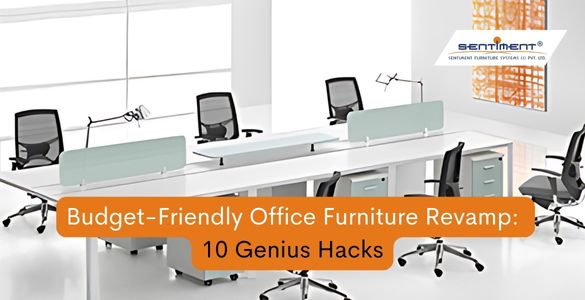
Anil Sharma (April 20, 2024 AT 4.00 PM)
In the realm of office design, the boss's cabin holds a unique significance. It’s not just a space for the manager or the leader; it’s a reflection of the company’s ethos, culture, and leadership style. In a small office setting, where every square foot counts, designing a boss cabin requires a delicate balance between functionality, aesthetics, and comfort. Let’s delve into the intricacies of designing a small office boss cabin, exploring key elements, design principles, and frequently asked questions.
○ In a small office, space optimization is paramount. Every inch of the boss cabin should be utilized efficiently without compromising comfort or functionality.
○ Opt for space-saving furniture such as wall-mounted desks, compact storage units, and multi-functional pieces like a desk that doubles as a meeting table.
○ Consider the flow of movement within the cabin to ensure easy accessibility to essential areas like the desk, seating area, and storage.
○ Aesthetics play a crucial role in creating a conducive work environment. Choose a design theme that reflects the company’s brand identity and the boss’s personal style.
○ Incorporate elements like ergonomic furniture, soothing color schemes, ample natural light, and tasteful decor to create an inviting ambiance.
○ Strike a balance between professionalism and personalization to ensure that the cabin exudes authority while also feeling warm and welcoming.
○ The boss’s cabin should be designed to facilitate productivity and comfort. Invest in ergonomic furniture to support good posture and reduce strain during long hours of work.
○ Ensure adequate lighting, both natural and artificial, to minimize eye strain and create a well-lit workspace.
○ Incorporate comfortable seating options for both the boss and visitors, such as plush chairs or a small sofa, to facilitate discussions and meetings.
○ Privacy is essential for confidential discussions and focused work. Install soundproofing materials to minimize noise disturbances from the surrounding office environment.
○ Consider adding frosted glass partitions or curtains to provide visual privacy without compromising natural light flow.
○ Optimize the cabin layout to minimize visibility from outside while maintaining a clear line of sight for the boss to supervise the workspace.
○ Efficient storage solutions are crucial in a small office boss cabin to keep the space organized and clutter-free.
○ Utilize vertical space by installing shelves or cabinets above the desk area to store books, files, and office supplies.
○ Incorporate built-in storage options wherever possible to maximize floor space without sacrificing storage capacity.
○ Embrace minimalism to create a clean and clutter-free environment that fosters focus and productivity.
○ Choose sleek and simple furniture designs with clean lines and minimal ornamentation to maximize space and visual appeal.
○ Prioritize functionality in every design decision to ensure that the boss cabin meets the practical needs of its occupants.
○ Opt for furniture and layout configurations that optimize workflow and facilitate efficient task completion.
○ Integrate natural elements such as plants, natural wood finishes, and stone accents to bring a sense of warmth and tranquility to the cabin.
○ Natural elements not only enhance aesthetics but also contribute to improved air quality and overall well-being.
○ Personalize the boss cabin with meaningful decor items, artwork, or memorabilia that reflect the boss’s interests, achievements, and personality.
○ However, ensure that personalization does not overwhelm the space or detract from its professional atmosphere.
○ Design the boss cabin with flexibility in mind to accommodate evolving needs and preferences over time.
○ Choose modular furniture and adjustable fixtures that can be easily reconfigured to adapt to changing work requirements.
○ Maximize natural light by positioning the desk near windows or glass walls and using sheer curtains or blinds that allow light to penetrate while providing privacy.
○ Use light-colored paint or reflective surfaces to bounce natural light deeper into the room.
○ Opt for wall-mounted desks, foldable tables, and nesting chairs that can be easily stowed away when not in use.
○ Choose multi-functional furniture pieces like storage ottomans or desks with built-in shelves and drawers.
○ Use frosted glass partitions or sliding doors to create visual privacy while maintaining an open and airy feel.
○ Position furniture strategically to create semi-private zones within the cabin without blocking light or airflow.
○ Light, neutral colors such as white, beige, or light gray can make a small space appear larger and more open.
○ Accentuate with pops of color through accessories or artwork to add personality and visual interest.
○ Conceal wires and cables with cable management systems or integrated cable channels to maintain a clean and uncluttered look.
○ Incorporate built-in charging stations, smart lighting controls, and integrated audio-visual systems for a seamless and tech-savvy workspace.
In conclusion, designing a small office boss cabin requires careful consideration of space, functionality, aesthetics, and comfort. By prioritizing efficiency, personalization, and flexibility, you can create a workspace that not only reflects the authority and professionalism of the boss but also fosters productivity and well-being for all occupants.

Small Office Boss Cabin Design

Office Furniture Manufacturers: Choosing Quality, Comfort, and Style for Your Workspace

10 Genius Hacks to Revamp Your Office Furniture on a Budget

10 Genius Hacks to Revamp Your Office Furniture on a Budget
.jpg)
Find quality & affordable modular office furniture?

Transform Your Office With Stylish Furniture